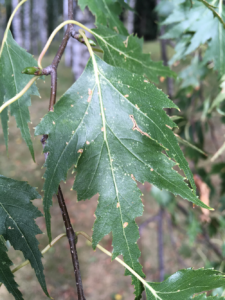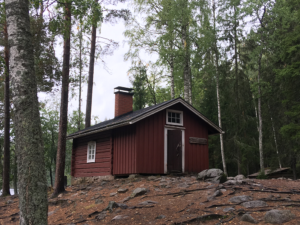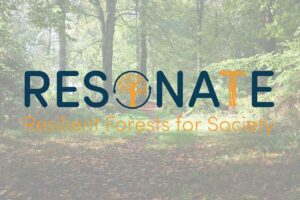
Erasmus+ Study Tour Experience
Claire Glaister FICFor tells the Institute about her experience on the Erasmus+ study tour, hosted by Tampere University of Applied Sciences (TAMK) and promoted by ARCH network. The study tour explored forests, birds and environmental education.
The NET project aims to improve staff competencies and add a European dimension to nature, conservation, interpretation, and environmental management for Scottish managers, trainer’s, advisors and training planners, ARCH work with a consortium of Scottish organisations, including the Institute, to deliver NET Programmes. View NET destinations here >>
Below you can read some of Claire’s experience from the Erasmus+ study tour.
A House of 100 Trees
On arrival in Finland, it was clear that we would be treated to spectacular skies and sunrises, landscapes and culture, and great hospitality.
That first night took us down an avenue of silver birch which, even accounting for the car’s headlights, seemed to shine brightly in front of us. The bark looked much brighter than we see on birch at home and certainly lived up to the tree’s silver title.

A cabin in the canyon
The majesty and splendour of the Helvetinjärvi National Park was mind-blowing and the first rain of the trip didn’t dampen our spirits one bit; if ever a description of a land of lakes and forests were warranted, it’s for places like this. Raine Kallio, our very experienced wilderness guide, took us on a 14km hike through the glorious scenery, helping us identify the numerous species of flora we discovered and to listen out for birds as we went.
We learned of the respect in which the Finish people hold the environment and their sense of peace with their surroundings. There seems to be an undeniable connection between people and forests which surely must, in part at least, be born out of the sheer extent of the forestry resource.
Our destination for lunch was a cabin in a canyon, accessible either by steps and boardwalks or by climbing down one of the channels leading into the canyon; we went the latter route on the way in.
Attempting to dry out by the heat of a freshly lit fire and enjoying much-needed food, we discussed how the cabin had been constructed by a group of young folk who used to come to the canyon to dance and can now be used as a refuge for walkers and hikers.
The scenic location reminded me of a dilemma often posed on Facebook; could you live here without Wi-Fi for a year for a £1,000,000?

Hatanpaan Puisto Arboretum
Walking through the arboretum, we were greeted by a plethora of plants and trees including snake spruce (Picea abies ‘virgata’ kaanrmekuusi) and silver birch with an unusually shaped leaf (Betula pendula f. crispa loimaankoivu), neither of which I’ve ever seen before. It’s true what they say about ‘every day is a school day’!
We also saw numerous (and, as we learned, very common) red squirrels – some almost tame – which caused us great delight and our hosts’ great amusement.
Whilst walking through the urban oasis, we couldn’t help but hear a group of schoolchildren enjoying a break from lessons. Kati, one of our student hosts explained that the school curriculum has recently changed so that lessons are more child-centered rather than a more traditional format which reminded me of Scotland’s Curriculum for Excellence approach. As well as taking breaks in the arboretum, some schools are also now running Forest Schools but Kati wasn’t aware of this extending to Forest Kindergartens.
From the relative peace and tranquility of the arboretum, we then entered the frenetic world of Tampere University of Applied Sciences (TAMK) at lunchtime.
After meeting one of the forestry lecturers, Pirjo Puustjarvi, we refuelled in the canteen and then became students ourselves as we sat in a classroom to hear more about education in Finland in general and the university in particular.
The Finnish education system has consistently been ranked as one of the highest in the world, teachers are well respected and children and encouraged to learn from an early age.
Finnish children start school at the age of seven (it is considered important for them to experience life and enjoy their childhood before this age) and follow nine years of compulsory education. After 6 years in ‘primary’ school, they then attend a further three years in the equivalent of secondary school and can then continue secondary education through either an academic or vocational route, usually for a further three years.
Tertiary education takes place at either a university or polytechnic (also known as a University of Applied Sciences). Tampere University of Applied Sciences hosts 10,000 students and offers bachelor’s and master’s degree programmes as well as vocational teaching education. Forestry programmes are also delivered at the University of Helsinki and the University of Eastern Finland at Joensuu.
The degree programme in forestry at TAMK is a four year bachelor-level professional higher education degree at EQF Level 6 (equivalent to SCQF Levels 9 (BSc (Ord), Technical Apprenticeships) and 10 (BSc (Hons), Professional Apprenticeships)). Student places tend to be oversubscribed at TAMK and in terms of their classes, our student hosts calculated that around 30% of the students were women.
After completion of their bachelor degree, graduates may then apply to study a master’s degree at a university or university of applied science; for the latter, at least 3 years of work in a related field is required.
The Scottish visitors then gave our presentations to some of the forestry students and the head of the degree programme, Ari Vanamo; mine being entitled ‘From legends to lorries via lifelong learning’.
I summarised my career, starting out with the then Forestry Commission Survey Branch in the New Forest (the legend was the questionably accidental death of King William II from a stray arrow at the place now marked by The Rufus Stone) through to my current work with timber transport. I also showed photos of the new entrants and apprentices I’ve had the privilege to work with as they start out in the industry. Finally I assured the students that I’ve undertaken lifelong learning too, not least by becoming a member of the Institute of Chartered Foresters (ICF) in 2001 and a Fellow in 2016.
Our hosts weren’t aware of an equivalent of the Institute of Chartered Foresters in Finland but advised that those forestry graduates who progress into the industry carry out job-specific training as required, rather than following a professional route after several years in post-qualification practice.
Presentations were given and questions were asked, a few by the Finnish students and some from the rest of the study tour delegates. We went back to our accommodation with our three student hosts for a BBQ, sauna and socialising.

But not before visiting some rather strangely growing pine on a slope behind the city cemetery. Their form, growth, and stability were questions we discussed further during the evening, although rather briefly as other, potentially more pressing, ones emerged – like how on earth are you supposed to breathe when you’ve plunged into the lake straight from the sauna!
Minds and bodies refreshed, we prepared for our forest hiking adventure the next day!
Claire had an amazing time and opportunity to network and share knowledge with others outside the UK. Keep your eye open for future opportunities through the Institute’s e-newsletter.
Disclaimer: The views and opinions expressed in this article are those of the author and do not necessarily reflect the views of the Institute of Chartered Foresters.






